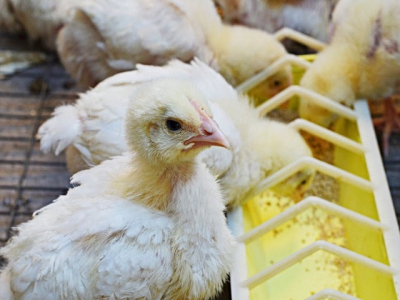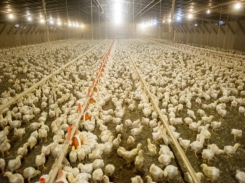In-feed boric acid use may aid chicken gut health, salmonella resistance

Adding boric acid to poultry feed may support gut health, limit salmonella expansion for birds facing a disease challenge, say researchers.
An international team of researchers from the US, Mexico and Brazil explored the use of boric acid in broiler diets as an alternative antimicrobial when birds faced a salmonella challenge.
“The objectives of the present study were to evaluate the anti-bacterial and intestinal integrity properties of boric acid (BA) on S. Enteritidis colonization, intestinal permeability, total intestinal IgA levels, and cecal microbiota composition in broiler chickens,” the researchers said.
The researchers found that birds receiving dietary boric acid had a reduction in salmonella levels in the crop and ceca-cecal tonsils (CCT) following a disease challenge. Birds on the trial diet also had a drop in serum fluorescein isothiocyanate dextran (FITC-d) and reduced intestinal IgA levels.
“Dietary BA administration had a significant reduction in serum FITC-d and lower total intestinal IgA levels, which are related to a better intestinal health,” they said. “Although in the microbiota analysis only the abundance of Actinobacteria phylum and the beta diversity were significantly different when comparing the groups, the results suggest that BA could maintain intestinal homeostasis, as well as the balance in the microbiota due to its effectiveness to control S. Enteritidis infection.”
Why feed boric acid?
Boron is a chemical element found in boric acid and an essential nutrient for plants and animals, the researchers said.
Previously, it has been used as a fertilizer, pesticide and in the production of glass, paint, cosmetics and ceramics
It also can be ingested as a component of food or water, they said. The element has been linked to several metabolic and physiological processes.
“In eukaryotes, boron plays a key role in mineral metabolism, immune response, endocrine system, and cellular structure,” they said. “In prokaryotes, boron participates as an autoinducer (AI-2) in quorum sensing responses. Hence, boron plays essential roles in the homeostatic biology of living organisms.”
In medicinal use, boron’s antimicrobial properties have seen it used as an alternative method to address fungal and protozoa vaginal infection and bacterial ear infections, the researchers said.
However, when highly concentrated, it is a poison and has been used to control several types of organisms including prokaryotes, invertebrates and vertebrates.
Addressing salmonella
Recent research into the use of boric acid (BA) found that 1%BA could eliminate levels of S. Enteritidis, the researchers said.
However, use of 0.1% BA cut the amount of S. Enteritidis by more than 2log10 when compared to a positive control in an in vitro examination using mimicked intestinal conditions, they said.
“Furthermore, a study that evaluated the prophylactic effect of 0.1% (w/w) BA into the feed in broiler chickens showed that BA reduced the concentration of S. Enteritidis >1 log10 in ceca-cecal tonsils (CCT), but not significantly,” they added.
Feeding trial details
During the feeding trial and disease challenge, 60 day-old broiler chicks were divided into two groups, which received either a corn-soybean-meal-based control diet or that feed with supplemental 0.1% BA, the researchers said.
All birds faced the disease challenge from a strain of S. Enteritidis also known to be resistant to novobiocin and nalidixic acid.
“Starter feed was used in this experiment and was formulated to approximate the nutritional requirements of broiler chickens as recommended by the National Research Council (1994) and adjusted to breeder's recommendations,” they said. “No antibiotics, coccidiostats or enzymes were added to the feed.”
Chicks received the oral disease challenge on day one, they said.
A selection of birds was collected on days 3 and 10 post-challenge and the crop and ceca-cecal tonsils were harvested to assess S. Enteritidis recovery and bird microbiota.
FITC-d concentration also was established on day 9, and select chickens received an oral gavage of FITC-d on day 10, the researchers said. Blood and intestinal samples were collected for analysis following bird harvest.
Results
On day 3 following the disease challenge, birds on the supplemented feeds had decreased levels of S. Enteritidis in the crop and CCT compared to birds on the control diet, the researchers said. By 10-days post disease challenge, the amount had “significantly decreased” for birds receiving the BA-supplemented diet.
“On day 10 post-challenge, BA significantly reduced S. Enteritidis colonization by 2.6 log10 in crop and 5.26 log10 in CCT,” they added.
There was no major difference in the total number of aerobic or lactic acid cecal bacteria for birds on either diet, they said.
But birds on the supplemented diet had reduced serum FITC-d concentrations and lower intestinal IgA amounts.
Salmonella has been linked to “leaky gut,” and FITC-d concentration and IgA amounts are considered biomarkers that can be used to check intestinal permeability and internal inflammation, they said.
“The reduction in serum FITC-d concentration and lower total intestinal IgA levels may be directly related to the decrease in the severity of S. Enteritidis infection due to the antimicrobial activity of BA. Although both Proteobacteria and Actinobacteria were lower in the BA group when compared to the control group, only significant differences were observed with Actinobacteria."
At the genus level, there were no significant differences, they said. However, the top-ranked bacterial families were different for birds receiving the different feeds.
“The results of the present study suggest that BA could maintain intestinal homeostasis, as well as the balance in the microbiota due to its effectiveness in controlling S. Enteritidis infection,” they said.
Source: Research in Veterinary Science
Authors: D. Hernandez-Patlan, B. Solis-Cruz, B. Adhikari, K. Pontin, J. Latorre, M. Baxter, X. Hernandez-Velasco, R. Merino-Guzman, A. Méndez-Albores, Y. Kwon, B. Hargis, R. López-Arellano, M. Arreguin-Nava, G. Tellez-Isaias
Related news
Tools

Phối trộn thức ăn chăn nuôi

Pha dung dịch thủy canh

Định mức cho tôm ăn

Phối trộn phân bón NPK

Xác định tỷ lệ tôm sống

Chuyển đổi đơn vị phân bón

Xác định công suất sục khí

Chuyển đổi đơn vị tôm

Tính diện tích nhà kính

Tính thể tích ao



 Using and talking about evidence correctly is important.…
Using and talking about evidence correctly is important.…  Biomin brings probiotics to hatchlings by giving them…
Biomin brings probiotics to hatchlings by giving them…